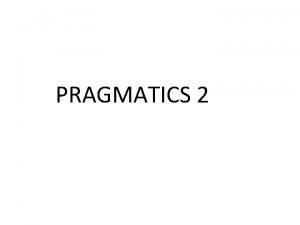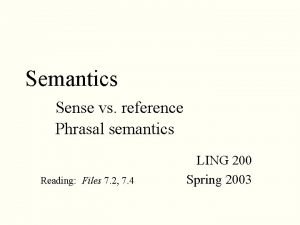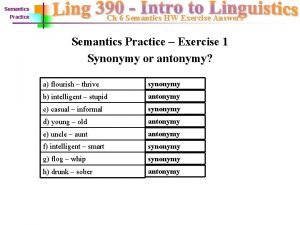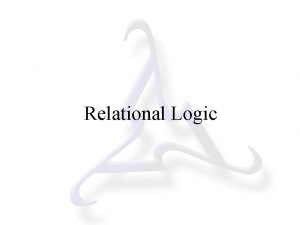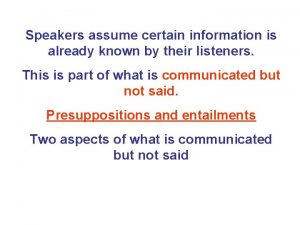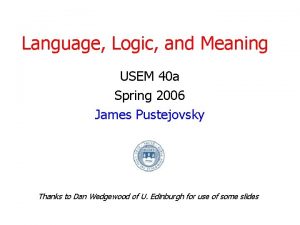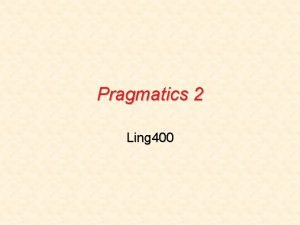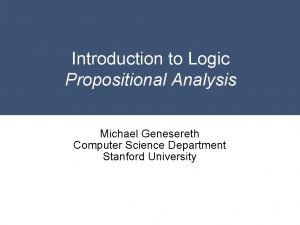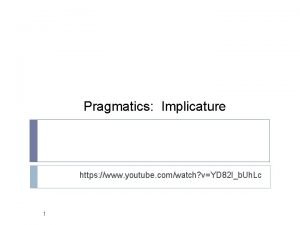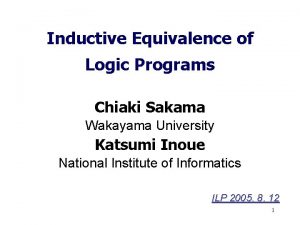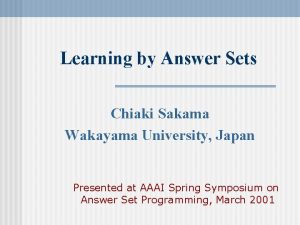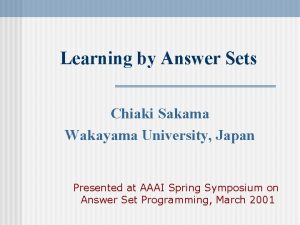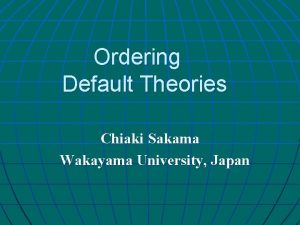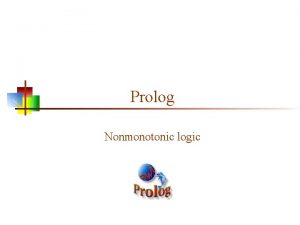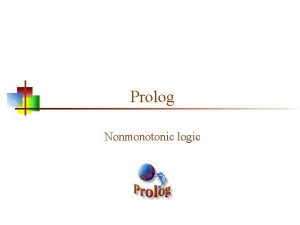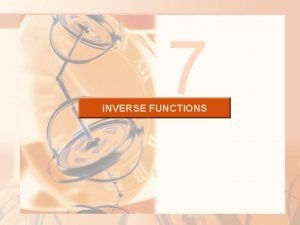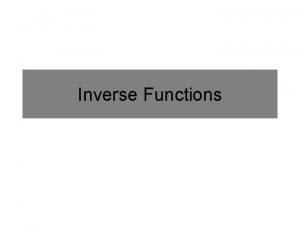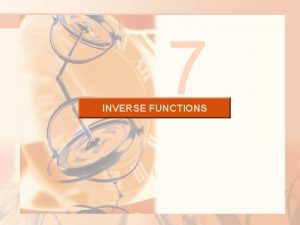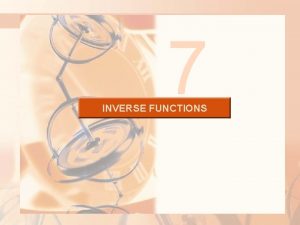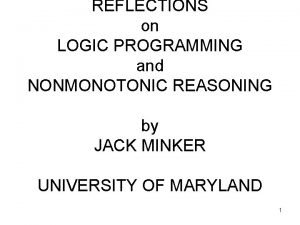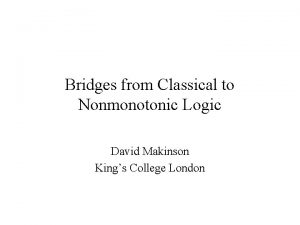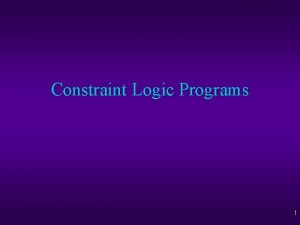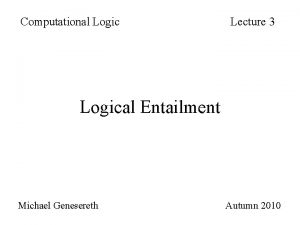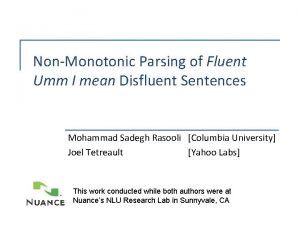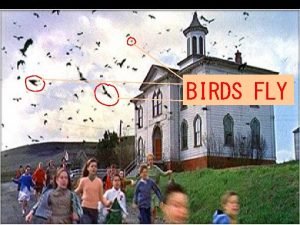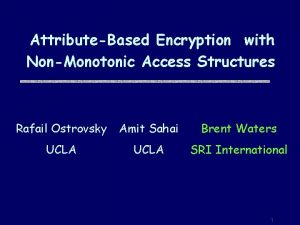Inverse Entailment in Nonmonotonic Logic Programs Chiaki Sakama




![Stable Model Semantics [Gelfond& Lifschitz, 88] An NLP may have none, or multiple stable Stable Model Semantics [Gelfond& Lifschitz, 88] An NLP may have none, or multiple stable](https://slidetodoc.com/presentation_image_h2/6ad82aa49842203fe17d5fa7acead4de/image-5.jpg)
![Problems of Deduction Theorem in NML [Shoham 87] In classical logic, T F holds Problems of Deduction Theorem in NML [Shoham 87] In classical logic, T F holds](https://slidetodoc.com/presentation_image_h2/6ad82aa49842203fe17d5fa7acead4de/image-6.jpg)




![Properties of Nested NAF [Lifschitz et al, 99] not A 1 ; … ; Properties of Nested NAF [Lifschitz et al, 99] not A 1 ; … ;](https://slidetodoc.com/presentation_image_h2/6ad82aa49842203fe17d5fa7acead4de/image-11.jpg)
















- Slides: 27

Inverse Entailment in Nonmonotonic Logic Programs Chiaki Sakama Wakayama University, Japan

Inverse Entailment B : background theory (Horn program) E : positive example (Horn clause) B H E B (H E) B ( E H) B E H A possible hypothesis H (Horn clause) is obtained by B and E.

Problems in Nonmonotonic Programs 1. 2. Deduction theorem does not hold. Contraposition is undefined. The present IE technique cannot be used in nonmonotonic programs. Reconstruction of theory is necessary in nonmonotonic ILP.

Normal Logic Programs (NLP) An NLP is a set of rules of the form: A 0 A 1,…,Am,not Am+1,…,not An (Ai : atom, not: Negation as failure) n A Nested Rule is a rule of the form: A R where R is a rule n An LP-literal is L HB+ where HB+=HB {not A | A HB } n
![Stable Model Semantics Gelfond Lifschitz 88 An NLP may have none or multiple stable Stable Model Semantics [Gelfond& Lifschitz, 88] An NLP may have none, or multiple stable](https://slidetodoc.com/presentation_image_h2/6ad82aa49842203fe17d5fa7acead4de/image-5.jpg)
Stable Model Semantics [Gelfond& Lifschitz, 88] An NLP may have none, or multiple stable models in general. n An NLP having exactly one stable model is called categorical. n An NLP is consistent if it has a stable model. n A stable model coincides with the least model in Horn LPs. n
![Problems of Deduction Theorem in NML Shoham 87 In classical logic T F holds Problems of Deduction Theorem in NML [Shoham 87] In classical logic, T F holds](https://slidetodoc.com/presentation_image_h2/6ad82aa49842203fe17d5fa7acead4de/image-6.jpg)
Problems of Deduction Theorem in NML [Shoham 87] In classical logic, T F holds if F is satisfied in every model of T. n In NML, T NML F holds if F is satisfied in every preferred model of T. n Proposition 3. 1 Let P be an NLP. For any rule R, P R implies P s R, but not vice-versa.

Entailment Theorem (1) Theorem 3. 2 Let P be an NLP and R a rule s. t. P {R} is consistent. If P {R} s A, then P s A R for any ground atom A. The converse does not hold in general. ex) P={ a not b} has the stable model {a}, then P s a b. P {b} has the stable model {b}, so P {b} s a.

Entailment Theorem (2) Theorem 3. 2 Let P be an NLP and R a rule s. t. P {R} is consistent. If P s A R and P s R, then P {R} s A for any ground atom A.

Contraposition in NLP In NLPs a rule is not a clause by the presence of NAF. n A rule and its contraposition wrt and not are semantically different. n ex) {a } has the stable model {a}, while { not a} has no stable model.

Contrapositive Rules Given a rule R of the form: A 0 A 1,…,Am,not Am+1,…,not An its contrapositive rule c. R is defined as not A 1 ; … ; not Am+1 ; … ; not An not A 0 where ; is disjunction and not A is nested NAF.
![Properties of Nested NAF Lifschitz et al 99 not A 1 Properties of Nested NAF [Lifschitz et al, 99] not A 1 ; … ;](https://slidetodoc.com/presentation_image_h2/6ad82aa49842203fe17d5fa7acead4de/image-11.jpg)
Properties of Nested NAF [Lifschitz et al, 99] not A 1 ; … ; not Am+1 ; … ; not An not A 0 is semantically equivalent to A 1,…,Am,not Am+1,…,not An ,not A 0 In particular, not A is equivalent to A not A is equivalent to not A

Contrapositive Theorem 4. 1 Let P be an NLP, R a (nested) rule, and c. R its contrapositive rule. Then, P s R iff P s c. R

Inverse Entailment in NLP Theorem 5. 3 Let P be an NLP and R a rule s. t. P {R} is consistent. For any ground LP-literal L, if P {R} s L and P s not L , then P {not L} s not R where P {not L} is consistent.

Induction Problem Given: n a background KB as a categorical NLP n a ground LP-literal L s. t. P snot L, L=A represents a positive example; L=not A represents a negative example n a target predicate to be learned

Induction Problem Find: a hypothetical rule R s. t. n P {R} s L n P {R} is consistent n R has the target predicate in its head

Computing Hypotheses When P {R} s L and P snot L , P {not L} s not R (by Th 5. 3) By P snot L, it is simplified as P s not R Put M+={ | HB+ and P s }. Then, M+ not R Let r 0= where M+. Then, M+ not r 0

Relevance Given two ground LP-literals L 1 and L 2, define L 1~L 2 if L 1 and L 2 have the same predicate and contain the same constants. L 1 in a ground rule R is relevant to L 2 if (i) L 1~L 2 or (ii) L 1 shares a constant with L 3 in R s. t. L 3 is relevant to L 2. Otherwise, L 1 is irrelevant to L 2.

Transformations 1. 2. 3. 4. When r 0 = 0 contains any LPliteral irrelevant to the example, drop them and put r 1= 1 When r 1= 1 contains both an atom A and a conjunction B s. t. A B P, put r 2= 1–{A}. When r 2= 2 contains not A with the target pred. , put r 3=A 2–{not A} Construct r 4 s. t. r 4 =r 3.

Inverse Entailment Rule Theorem 5. 5 When Rie is a rule obtained by the transformation sequence, M+ not Rie holds. When P Rie is consistent, we say that Rie is computed by the inverse entailment rule.

Example(1) P: bird(x) penguin(x), bird(tweety) , penguin(polly). L: flies(tweety). target: flies M+={bird(t), bird(p), penguin(p), not penguin(t), not flies(p)}

Example(1) r 0: bird(t), bird(p), penguin(p), not penguin(t), not flies(p). Dropping irrelevant LP-literals: r 1: bird(t), not penguin(t), not flies(t). Shifting the target to the head: r 3: flies(t) bird(t), not penguin(t). Replacing tweety by x: r 4: flies(x) bird(x), not penguin(x).

Example(2) P: flies(x) bird(x), not ab(x), bird(x) penguin(x), bird(tweety) , penguin(polly). L: not flies(polly). target: ab M+={bird(t), bird(p), penguin(p), not penguin(t), flies(p), not ab(t), not ab(p)}.

Example(2) r 0: bird(t), bird(p), penguin(p), not penguin(t), not ab(p). Dropping irrelevant LP-literals: r 1: bird(p), penguin(p), not ab(p). Dropping implied atoms in P: r 2: penguin(p), not ab(p). Shifting the target and generalize: r 4: ab(x) penguin(x).

Properties of the IE rule It is not correct for the computation of rules satisfying P {R} s. L. The meaning of a rule changes by its representation form. n It is not complete for the computation of rules satisfying P {R} s. L. The transformation sequence filters out useless hypotheses. n

Correctness Issue a b, c = b a, c = c a, b = a, b, c ★ Independence of its written form a b, c not b not a, c not a, b, c ★ Dependence on its written form

Completeness Issue B: q(a) , r(b) r(f(x)) r(x) E: p(a) H: p(x) q(x), r(b) p(x) q(x), r(f(b)), …… ! Infinite number of hypotheses exist in general (and many of them are useless)

Summary New inverse entailment rule in nonmonotonic ILP is introduced. n The effects in ILP problems are demonstrated by some examples. Future research includes: n Extension to non-categorical programs (having multiple stable models). n Exploiting practical applications. n
 Types of presupposition
Types of presupposition Collection of programs written to service other programs.
Collection of programs written to service other programs. Third order logic
Third order logic Majority circuit
Majority circuit Combinational vs sequential logic
Combinational vs sequential logic Combinational logic sequential logic 차이
Combinational logic sequential logic 차이 First order logic vs propositional logic
First order logic vs propositional logic Cryptarithmetic problem logic+logic=prolog
Cryptarithmetic problem logic+logic=prolog Logic chapter three
Logic chapter three First order logic vs propositional logic
First order logic vs propositional logic 캠블리 단점
캠블리 단점 What is phrasal semantics
What is phrasal semantics Semantic exercise
Semantic exercise What are entailments
What are entailments Logical entailment
Logical entailment Presupposition and entailment
Presupposition and entailment Entailment
Entailment Linguistic meaning
Linguistic meaning Difference between entailment and implicature
Difference between entailment and implicature Entailment observasi
Entailment observasi Consistency logic
Consistency logic Implicature
Implicature Entailments definition to kill a mockingbird
Entailments definition to kill a mockingbird Sabbath school ideas
Sabbath school ideas Emt 248
Emt 248 Adobe certified associate certification programs
Adobe certified associate certification programs Harvard study abroad
Harvard study abroad Lvn to bsn in california
Lvn to bsn in california
